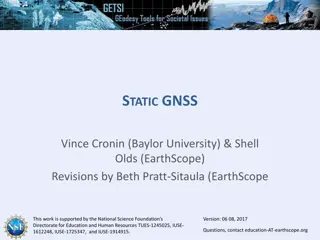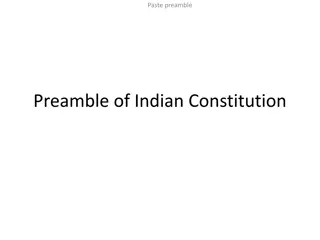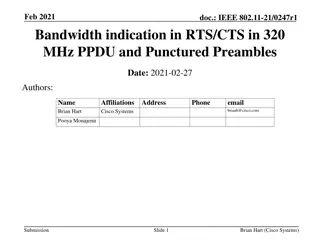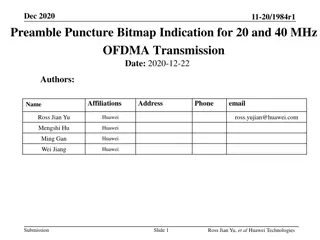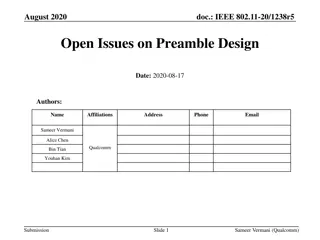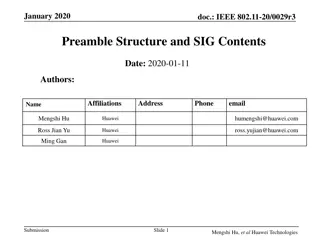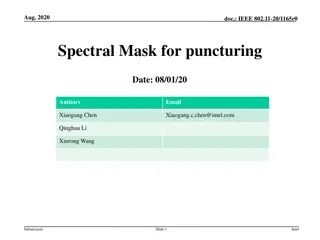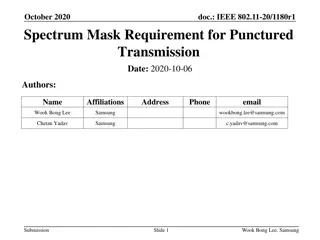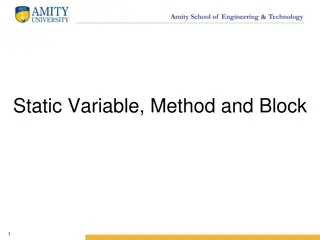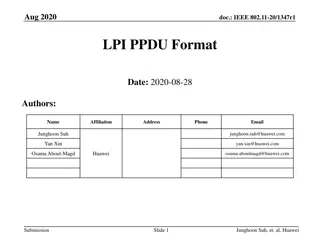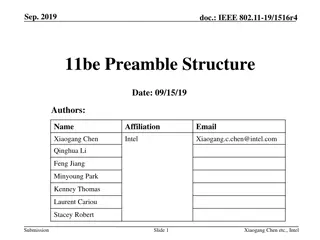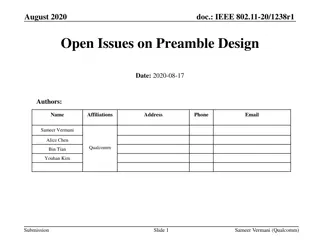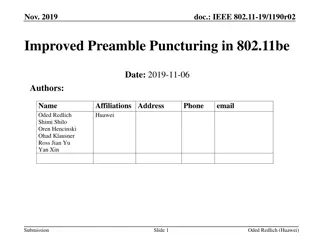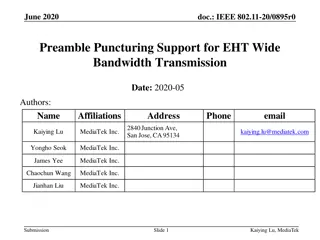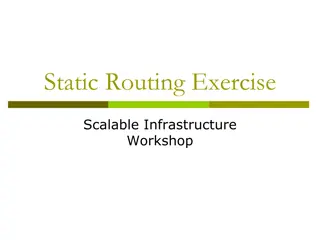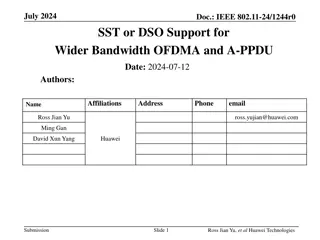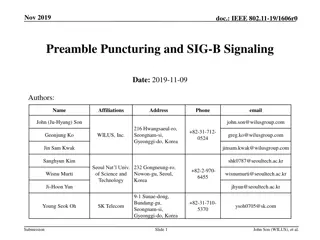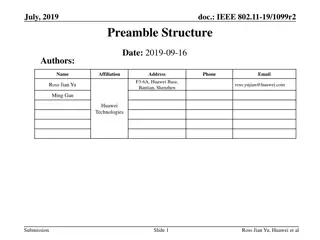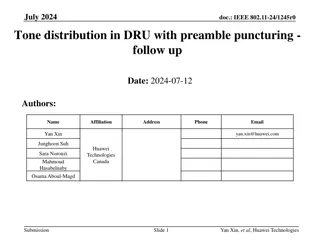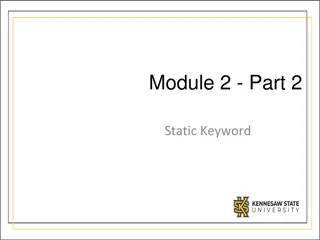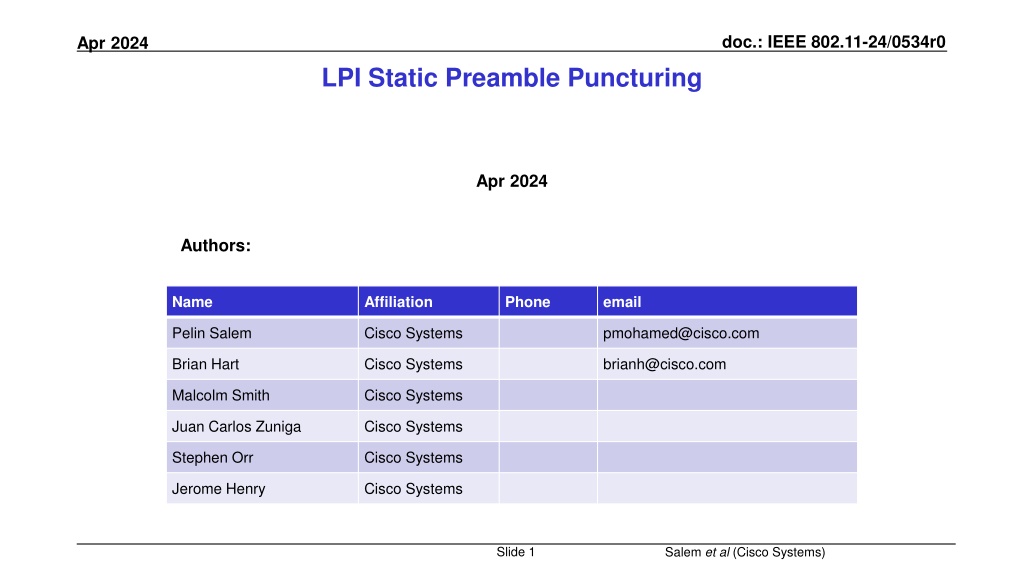
Static Preamble Puncturing in IEEE 802.11 Standards
Explore the innovation of Static Preamble Puncturing in IEEE 802.11 standards, its benefits in addressing interference issues, and compliance with FCC regulations in the 6GHz band. Learn about Transmit Spectral Masks, EIRP PSD representations, and more in this informative content.
Download Presentation

Please find below an Image/Link to download the presentation.
The content on the website is provided AS IS for your information and personal use only. It may not be sold, licensed, or shared on other websites without obtaining consent from the author. If you encounter any issues during the download, it is possible that the publisher has removed the file from their server.
You are allowed to download the files provided on this website for personal or commercial use, subject to the condition that they are used lawfully. All files are the property of their respective owners.
The content on the website is provided AS IS for your information and personal use only. It may not be sold, licensed, or shared on other websites without obtaining consent from the author.
E N D
Presentation Transcript
doc.: IEEE 802.11-24/0534r0 Apr 2024 LPI Static Preamble Puncturing Apr 2024 Authors: Name Affiliation Phone email Pelin Salem Cisco Systems pmohamed@cisco.com Brian Hart Cisco Systems brianh@cisco.com Malcolm Smith Cisco Systems Juan Carlos Zuniga Cisco Systems Stephen Orr Cisco Systems Jerome Henry Cisco Systems Slide 1 Salem et al (Cisco Systems)
doc.: IEEE 802.11-24/0534r0 Apr 2024 The Promise of Static Preamble Puncturing P20 S20 P20 S20 S40 S40 X P X X -62 dBm CCA-CatchAll -62 dBm CCA-CatchAll I I Key: I = interference, P = Punctured subchannel Static preamble puncturing was first introduced in 11ax and was enhanced in 11be Now possible with SU or OFDMA PPDUs, and for sounding The promise was: If an incumbent needed protection or there was persistent interference, which would prevent full bandwidth transmission, Static Preamble Puncturing would still permit full bandwidth transmission, albeit with the affected subchannels disabled. Slide 2 Salem et al (Cisco Systems)
doc.: IEEE 802.11-24/0534r0 Apr 2024 Current FCC Regulations for Preamble Puncturing in 6GHz Note the Preamble Puncturing is not allowed with LPI BSSs (clause 2 at bottom right) Subsequent communications provide only partial relaxation here (see next slide) 789033 D02 General UNII Test Procedures New Rules v02r01 987594 D02 U-NII 6 GHz EMC Measurement v02r01 FCC: Federal Communications Commission DFS: Dynamic Frequency Selection EMC: Electromagnetic Compatibility AFC: Automatic Frequency Control LPI: Low Power Indoor Slide 3 Salem et al (Cisco Systems)
doc.: IEEE 802.11-24/0534r0 Apr 2024 IEEE Transmit Spectral Masks and FCC Requirement 99% OBW 0.477 MHz +79.523 MHz 99% OBW +39.679 MHz 99% OBW -19.679 MHz +0.328 MHz +39.672 MHz -79.672 MHz -40.328 MHz 99% OBW -39.938 MHz -20.062 MHz Case 1: 80 MHz EHT PPDU with the lowest 20 MHz subchannel punctured (P-U-U-U) 99% OBW Case 2: 160 MHz EHT PPDU with the second lowest 40 MHz subchannel punctured (U-P-U-U) Case 3: 80 MHz EHT PPDU with the lowest 20 MHz subchannel punctured (U-P-U-U) IEEE Transmit spectral masks for various EHT PPDUs with different punctured subchannels fit the FCC requirement of 99% occupied bandwidth fitting outside the punctured channel (i.e., 0.5 ??? 1%). (Transmit Spectral Mask drawings Source: IEEE P802.11be/D5.0, November 2023) Slide 4 Salem et al (Cisco Systems)
doc.: IEEE 802.11-24/0534r0 Apr 2024 Simple Representation of Static Preamble Puncturing For EIRP PSD in an 80 MHz BSS: AP calculates max TX PSD for clients per 20 MHz channels from the AFC frequency response minus 6 dB, then signals these values in the EIRP PSD fields in the Transmit Power Envelope element. 20 of S40 (S40-lo) 20 of S40 (S40-hi) P20 S20 A = AFC frequency response - 6 dB X B = A - X Basic algorithm: Populate each EIRP PSD value with the integration of each black line over its 20 MHz: EIRP PSD = black line + 10*log10(20MHz/1MHz) Salem et al (Cisco Systems) Slide 5
doc.: IEEE 802.11-24/0534r0 Apr 2024 Summary of Static Preamble Puncturing FCC Rules Incorporating additional communications Standard Power (SP): Puncturing is allowed; devices protect incumbents by keeping their emissions below the limits provided by AFC system. Low Power Indoors (LPI): Puncturing is allowed for network optimization purposes: e.g., persistent interference in some part of the channel like another 20 MHz-only BSS. Puncturing is NOT allowed in the case of contention protocol testing. This means that a BSS needs to completely vacate a subchannel once incumbents are detected there (e.g., by lowering the BSS bandwidth) Dynamic Frequency Selection (DFS): Puncturing is allowed; need to ensure 99% BW. However, the 99% BW of 802.11 PPDUs excludes channels where DFS-triggering signals are found. Slide 6 Salem et al (Cisco Systems)
doc.: IEEE 802.11-24/0534r0 Apr 2024 Modified CCA/CS can be a solution for puncturing in LPI Traditional CCA: Key: P: Punctured channel I: Interference Modified CCA: P20 S20 P20 S20 S40 S40 P -42 dBm -62 dBm CCA-CatchAll -62 dBm CCA-CatchAll I Transmission allowed Transmission allowed I I P20 S20 P20 S20 S40 S40 P P -42 dBm -62 dBm CCA-CatchAll -62 dBm CCA-CatchAll I I I Transmission disallowed Transmission allowed Traditional physical carrier sense is backstopped by detection of any signal above a fixed threshold, -62 dBm The CCA-CatchAll threshold can be modified per subchannel, and a raised/relaxed threshold for punctured channels provides balanced collision protection. Specifically, the CCA-CatchAll threshold can be raised by a fixed amount such as 20 dB as shown above (or by the same amount as the STA s puncture depth). Slide 7 Salem et al (Cisco Systems)
doc.: IEEE 802.11-24/0534r0 Apr 2024 Summary 11be does not perform CCA over punctured subchannels and the FCC currently does not permit Static Preamble Puncturing in LPI BSSs as an allowed method to protect incumbents If an incumbent occupies the upper or lower half of an 80 MHz channel, the LPI BSS bandwidth drops to 40 MHz If an incumbent occupies the upper or lower half of a 160 MHz channel, the LPI BSS bandwidth drops to 80 MHz However, we see good prospects for FCC allowing Static Preamble Puncturing with modified CCA in LPI BSSs to protect incumbents De-sensed CCA, rather than no CCA, over the punctured subchannels To unlock 60 MHz BSSs (etc) instead of falling to 40 MHz. To unlock 120-140 MHz BSSs instead of falling to 80 MHz. Clients that support the modified CCA scheme can occupy the full (albeit punctured) BSS bandwidth instead of a fraction of it. Slide 8 Salem et al (Cisco Systems)
doc.: IEEE 802.11-24/0534r0 Apr 2024 Strawpoll To help regulators permit LPI BSSs to use Static Preamble Puncturing as a sufficient method to protect incumbents, do you agree to add the following text to the 11bn SFD: 11bn shall define a mode of operation where transmission on punctured subchannels is conditional on performing de-sensed CCA (details TBD) Y / N / A Slide 9 Salem et al (Cisco Systems)

